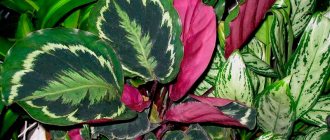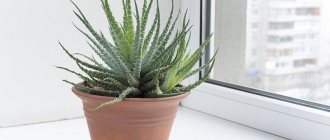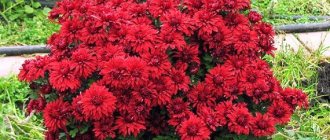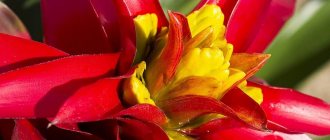In this article you will learn about the conditions for caring for anthuriums at home and transplanting a young anthurium after purchase.
House Anthurium is a special plant brought to us from countries with a hot, humid tropical climate. In addition, the anthurium flower in its natural environment often grows not even on the ground, but on tree branches, using the bark as a nutrient medium. You should take all these features of anthurium into account when caring for it at home. Below we will provide brief recommendations on how to care for anthurium in summer and winter, how to water anthurium, how to properly replant anthurium and other information necessary for every anthurium grower.
How to determine that a transplant is needed?
A plant may need to be replanted for several reasons:
- Within 3 days, the anthurium should be transplanted from purchased peat into a substrate for flowering plants, otherwise the flower will die.
- If the roots become cramped in the pot. In this case, the roots will stick out from the drainage holes, so replanting should be done as soon as possible. Otherwise, after 1-2 weeks the roots will come out and may be injured during transplantation.
- If the watering regime is violated, if there is rotting of the roots of the plant, as evidenced by the appearance of mold on the surface of the soil. Simultaneously with transplantation into fresh substrate, treatment with fungicides will be required.
- When the bush loses its decorative effect, it becomes lethargic and exhausted. In this situation, pest attacks are possible. Therefore, you should examine the roots of the flower, treat it with special means and transplant the anthurium into new soil.
- The soil in the pot with the plant has become depleted, as evidenced by the appearance of a white coating on its surface.
- When a flower loses its decorative effect. One of the reasons for this behavior may be an incorrectly selected substrate, therefore, the anthurium needs to be replanted.
Flower growers' headaches: care problems and how to solve them
Growing “male happiness” at home is not easy because of its capricious nature. Instead of admiring the beauty of the plant, you often have to think about how to save the “pet”. Why do anthurium leaves turn black and the plant begin to turn yellow and dry out? Most flamingo flower diseases are caused by improper care. You can save the plant if you work on the mistakes. And here it is important to determine the cause of the problem, which the following table will help with.
Table - Problems when growing anthurium and their causes
| Problem | Causes |
| The leaves are turning yellow | — Long-term waterlogging of the earthen coma; - chlorinated water; — too concentrated recharge; — insufficient lighting; - tight container |
| Leaves turn black | — Drafts; - too dry air; — violation of the temperature regime (too hot or cold); - direct rays of the sun; - substrate with excess potassium |
| Brown spots | — Overmoistening; - unsuitable soil; — damage to the root system; — hypothermia of roots; - hard or too cold water |
| The tips of the leaves dry out | — Anthracnose (weakened plants and flowers with mechanical damage get sick) |
| The plant dries up | — Insufficient watering; - dry air |
| The leaves are curling | — Drafts; - dry air; - lack of light |
| Wilting foliage | — Root rotting from overwatering |
In order for the “flamingo flower” to delight you with its beauty for a long time, you need to learn all the subtleties of care. If comfortable conditions are created for the tropical guest, the leaves will have to be trimmed only because of “old age”, and not because they have lost their attractiveness.
By optimizing care, many problems can be solved. But if rotting of the roots occurs, then you need to immediately replant the plant. The longer you delay replanting, the less chance you have of saving the flower. When replanting, you need to cut off the affected root parts, leaving the remaining parts in the air for half an hour to dry. If you plan to simply replace the soil, leaving the same container, be sure to disinfect it with a strong manganese solution.
How to replant after purchase?
When purchasing, you should examine the appearance of the anthurium, as well as its roots for diseases. At home, you can remove the plant from the planting pot and if there is no damage or rot on the roots, then we replant it after a couple of days , when the flower adapts to the new environment.
If these signs are detected, transplantation is carried out immediately:
- We remove the anthurium from the planting pot and straighten the roots.
- We cut off the rotten roots with a sharp knife or scissors. Damaged leaves should also be removed.
- Next, the anthurium needs to be treated with special preparations, such as Epin, Zircon or Fitosporin.
- We plant it in a new substrate.
- We place the plant in a well-lit place and care for it in accordance with the recommendations.
Botanical description
In its natural environment, Anthurium is found in regions with a tropical climate. The perennial from the araceae family surprises with its diversity: biologists count more than 500 species. There are also those growing on trees, and those that have taken a fancy to rocks, and herbaceous plants.
All species have the same flower structure: a spadix and a large bract-veil. But the color of the spathe and the base of the inflorescence are different. White, yellow, all shades of red - this is just a small list. The leaves of the flower are petiolate, but there are different shapes, colors, and sizes: huge and small, plain and with pronounced veins, whole or carved. The duration of flowering depends on the variety and proper care: some species can delight with flowers for a whole year without interruption.
You need to be careful when contacting aroid plants: they are poisonous. The handsome anthurium is no exception. The juice of the flower contains oxalate, which can even cause swelling in the throat. Don't worry: swelling can only happen if you chew the leaves. Consider a place for your “pet” so that it cannot be reached by children and pets. To plant an anthurium flower or carry out other manipulations, it is recommended to use gloves.
How to transplant and rejuvenate an old anthurium?
Anthurium is characterized by aerial roots, with the help of which the adult plant is rejuvenated. There are three ways to root the apical cutting:
- It is necessary to cut off the top of the plant with several rudiments of aerial roots and plant it in loose soil. We take a small container and do not bury the socket. To keep the soil loose, add a little charcoal, moss, vermiculite, coconut fiber and pine bark. Water the seedling abundantly so that water flows out of the drainage holes.
- We wrap the top of the flower with moss and regularly spray it with water until the roots grow through it. After this, we carefully cut off the top along with the roots and plant it in a new place.
- We cut off the tops and place them in a small container with water and wait for the roots to form. Then we transplant the plants into pots.
How to provide moisture for a plant
Ideally, you should have a device at home to maintain optimal humidity - a humidifier. If it is not possible to purchase a device, regularly spray the leaves of the plant with cool water from a spray bottle.
Important!
Place pebbles at the bottom of the tray and water the plant generously. This measure will help avoid the flower from drying out if you need to leave home for 7–10 days.
To ensure the required level of humidity, the plant can be grown near aquariums. Place baths of water on the radiator - the moisture will gradually evaporate. Another effective way to increase the humidity level in a room is to grow ficus, dracaena, and parmania. These plants humidify, purify and ionize indoor air.
Anthuriums look impressive and original. Plants are used to decorate the interiors of apartments and offices. Flowers not only please the eye, but also, according to Feng Shui, remove negative energy from the house. The flower brings good luck, attracts cash flows, and relieves negative emotions.
What kind of pot do you need?
For planting, you can choose either a plastic or clay flowerpot. However, when using the latter, the roots may grow into the walls, after which the plant will be difficult to replant. Before replanting the flower, make sure there are drainage holes in the bottom or sides of the pot.
Size and shape also matter -
the new pot should be 2-3 cm more spacious than the previous one , and the height should be greater than the width.
The container is selected depending on the reason for the transplant:
- for more luxuriant flowering, you should choose a pot that is only 2 cm larger than the old one;
- as the roots grow, the volume increases by 2-3 cm;
- for children, a few small pots or plastic glasses of 200 g volume are enough;
- when shoots are required for anthurium propagation, the capacity should also be increased. However, remember that in this case the plant will not bloom until the roots entwine the earthen ball.
Don’t forget to disinfect the transplant container by washing it with laundry soap (72%) and pouring boiling water over it.
When will the baby anthurium bloom?
A very small anthurium plant (baby) will bloom no earlier than in three years. Consider this when choosing the size of anthuriums.
In this video you will see what an anthurium flower, which is sometimes called a male anthurium flower, looks like. The video shows the flowering of 10 varieties of anthurium.
In this video we will give advice on which pot to choose for anthuriums, including which pot is suitable for growing orchids.
Have you bought an anthurium flower or are you going to buy a male happiness flower? Be sure to first study the recommendations for caring for anthuriums at home. In this video we have collected basic recommendations for caring for anthuriums.
Step-by-step instructions for transplantation
The transplant is carried out in several stages:
- The day before the start of the procedure, thoroughly moisten the soil so that the anthurium can be easily removed from the pot. You can put the pot in a bowl of water for a while.
- In order not to damage the roots, we pull out the flower along with the earthen lump, clean the roots from the soil and inspect for the presence of diseases and harmful insects.
- If there are pests, we treat with Actellika solution, and cut off the non-viable parts of the plant with sharp scissors.
- We remove dried flowers and leaves from the bush.
- We put drainage in a new pot, sphagnum moss and substrate for flowering plants on top of it, and make a small depression for the roots.
- We place the anthurium in the center of the pot, straighten the roots, and fill the voids with soil. If the roots are above the ground, cover them with moss.
- We place the flower on the windowsill of a western or eastern window, watering it as the top layer of soil dries.
Reasons for replanting anthurium
When growing a flower, you need to understand when it needs a change of soil. For anthurium, transplantation is performed in the following cases:
- Immediately after purchase. Within three days it is necessary to replace the soil and container;
- Excessive increase in plant root mass. They check it every year. If the lump of earth is practically invisible due to the roots, it is changed;
- Until the age of 5, the plant should be planted in a new pot every year;
- The flower looks exhausted and lethargic. It is important not only to change the soil, but also to inspect the roots for the presence of pests. If they exist, it is worth taking all necessary measures to save the plant;
- Incorrect watering schedule. If such a problem occurs, you need to replant the flower and treat the roots with appropriate fungicides;
- Mold. It can appear inside or outside the soil;
- Soil depletion begins. This can be determined by the white coating that appears due to deposited salts and minerals;
- Roots began to poke out of the drainage holes.
Important! In the process of changing soil and pot, you should carefully handle the roots. They shouldn't break off.
Roots must be treated with care when transplanting
After care
To maintain a flower, it is important to create a favorable environment - the temperature should be 20-25 degrees , and the plant loves the sun very much. In addition, anthurium is accustomed to high humidity, so from the first days of purchase it is necessary to establish a watering regime and provide the plant with moist air.
Immediately after transplantation, the plant cannot be fertilized until new flower stalks appear on it. This will happen after about 2.5 months. After they appear, use special products to achieve lush flowering.
Pests and diseases
As a result of illiterate care, the anthurium can get sick. Several types of pests parasitize its green, lush foliage.
- Aphid. It is characterized by a colonial distribution system. All individuals live on the underside of the leaf blade, so it is quite difficult to notice them immediately. Signs of its appearance are as follows: the foliage is curled and discolored;
- the plant dries out;
- growth slows down.
To eliminate the problem, insecticide treatment will be required.
- Scale insects. Bugs are brownish-beige in color. Pests feed on sap. Signs of their appearance: the outside of the leaves are covered with dark sticky spots, and brown tubercles are visible on the reverse side. The result is slow growth and death of the plant. To destroy parasites, you will have to resort to special treatment; ordinary insecticides are powerless here.
A systemic product is purchased at specialized retail outlets, after which the plant is treated with mineral oil.
- Spider mites. Due to their miniature size, they cannot be seen with the naked eye. But it is possible to determine the infection, since it is accompanied by the appearance of cobwebs. The foliage curls up. The control method is as follows: the leaves are washed with a warm soapy solution, then the flower is sprayed with acaricides.
- Thrips. Flies are dangerous because they infect anthurium with viruses, and their secretions contribute to the appearance of fungal diseases. The foliage takes on a yellowish-white hue. To combat them, you will need special tools, which are best purchased in the store.
When parasites appear, you must not hesitate, otherwise the plant will die or infect neighboring ones.
Infections affect the appearance of anthurium. Using them, you can determine the type of disease and its causes. Among the diseases, we will highlight the most common ones.
- Fusarium is a fungus, the effect of which is determined by withering and yellowing leaves and bending of stems. To protect the soil, it should be spilled with a fungicide, which is also used to treat the plant itself.
- Anthracnose is also a fungal infection that causes drying of shoots and foliage. It kills a flower in a month, since its spread is fleeting. Brown spots with an accumulation of spores are clearly visible on the leaf blades. As a treatment, it is recommended to remove infected foliage and treat with copper sulfate, while watering is reduced.
- Septoria. Distinctive signs are the appearance of yellow and brown spots, after which the leaves dry out and fall off. In this case, you need quick help. All affected areas are cut off, the soil and above-ground parts are sprayed with copper sulfate, and after some time they are treated with fungicides.
We must not forget that the appearance of parasites and infections can be prevented. It is enough to properly care for the plant.
How to water?
The watering regime for anthurium directly depends on the time of year. In hot weather it should be intense and carried out as the top part of the soil dries. With the onset of cold weather, not so much moisture is required, so watering is gradually reduced (to about once a week).
The main problem with indoor anthurium is stagnation of water in the roots, so
after each watering you need to empty the tray .
The water should be drained after 30 minutes. Watering should be carried out using two methods - directly into the pot with the plant and into the tray, alternating them with each other. This technique will avoid stagnation of moisture and protect the roots.
The water should be soft, without any impurities, and its temperature should be familiar to the flower. To soften, you can use citric acid or soften water by freezing, settling or boiling.
Anthurium loves high humidity. This epiphyte will need regular spraying, and once a week you can give it a warm shower.
Transplantation methods, possible options
1. Anthurium roots are healthy. The trunk is long and when transplanting, the plant is planned to be deepened. We showed an excellent, and most importantly, safe way to grow roots on a trunk in a video clip: How to rejuvenate anthurium, a 100% safe way
2. If for some reason this method is not suitable for you, and you decide to deepen the plant when replanting using the traditional method, then remove the long, old roots when planting.
They will no longer be able to work at full capacity and can be damaged during planting. In addition, when deepening, the lower roots will go deep into the soil, which already implies choosing a pot that is large and too deep. Which, in the future, can cause stagnation of water in the lower part of the pot, because poorly functioning roots will consume little moisture, which will cause stagnation and provoke the process of root rotting.
3. If there are healthy roots or a large amount of air, the plant can be planted directly into the ground.
It is better to use soil of 2 compositions for planting : What and how to prepare soil of the second composition?
4. If the plant does not have any roots left, and there are not too many air roots, or they are absent altogether, then a greenhouse and sphagnum moss can be used for growing.
More details on our website: Growing anthurium roots in a greenhouse
Instead of sphagnum, some gardeners use perlite, Seramis, etc.
Watering anthurium after transplantation
After transplanting the anthurium, you should be very careful about watering. Overmoistening the soil stops the flow of air to the roots, which leads to rotting of the root system. Overdrying of the soil is no less dangerous, leading to loss of turgor, wilting, falling leaves, buds and drying of the roots.
Systematic overdrying stops the growth of the root system. The root system of an anthurium, immediately after transplantation, cannot work at full strength; it consumes less moisture, so the soil takes a long time to dry out. At first, watering can be replaced by spraying the top layer of soil.
Read more: How to properly water anthurium
Feeding plants after transplantation
Until the plant begins to grow, root feeding is not recommended; it should be replaced with leaf feeding.
Read more in the forum topic: When does a plant need foliar feeding? How to carry them out correctly?
With the right approach to transplantation and, subsequently, to the creation of good conditions, high air humidity, temperature, and most importantly, intense lighting with a daylight duration of 12-14 hours, your plants will quickly adapt and grow well.
Read more about favorable conditions for the development of anthurium in the section: Everyday chores in caring for our flowers
Possible mistakes
Often, if transplanted incorrectly, problems arise related to the health of the anthurium:
Anthurium does not bloom after transplantation . This is possible for two reasons:
- if the container is too spacious, replace the pot with a smaller one;
- due to poor soil or improper selection of substrate.
The leaves of the flower turn yellow . There are several reasons for this:
- the flower has not yet had time to adapt to new conditions;
- During the transplantation, the root system of the anthurium was damaged;
- The plant's watering regime is not adjusted.
The leaves turn black and the roots rot - a consequence of intensive watering, which should be reduced, and if this does not help, replant.
Thus, in order to help the plant, you should understand and then eliminate the causes of poor health after transplantation.
Caring for anthuriums in winter
In winter, watering the anthurium should be reduced and you can even lower the temperature a little, but not below plus 18 degrees. If pots with anthuriums are placed on a windowsill in winter, make sure that the leaves do not touch the cold glass, as the anthurium may get sick. Anthurium is a shade-tolerant plant, but the plant needs a lot of light. The light should be diffused, without direct sunlight, otherwise the leaves and flowers will lose their attractive appearance. In low light, anthurium does not grow or bloom!
Transplantation during flowering
Beginning flower growers often wonder whether it is possible to replant a crop during flowering, because most often exotic flowers are sold with open buds. Typically, such manipulations are not carried out with representatives of indoor flora; they wait until the end of flowering or the onset of a dormant period. Anthurium flowers have a special structure; it is not easy to damage the leathery bract during replanting. After acquisition, a healthy bush is replanted after 1-2 weeks using the transshipment method.
Experts advise removing flower stalks to stimulate rooting. Then “male happiness” will not have to waste energy on flowering and conquering new space. If the ear is already covered with pollen, you can put the cut flowers in water. They will decorate your home for 4-5 weeks.
Methods of watering athurium
To water anthurium, it is better to use settled water at room temperature. The plant is mainly watered from above into the pot, but this can also be done through a tray. When top watering, water should be poured until it appears in the pan. Then let the flower stand for 30 minutes and drain off all the liquid that has drained. When constantly watering anthurium through a tray, it is necessary to use the surface method from time to time so that the ground is completely saturated with moisture. If the tips of the leaves begin to dry out, brown spots appear on them, and the flowers quickly fade, it means that the anthurium does not have enough moisture.
Methods of watering athurium
To water anthurium, it is better to use settled water at room temperature. The plant is mainly watered from above into the pot, but this can also be done through a tray. When top watering, water should be poured until it appears in the pan. Then let the flower stand for 30 minutes and drain off all the liquid that has drained. When constantly watering anthurium through a tray, it is necessary to use the surface method from time to time so that the ground is completely saturated with moisture. If the tips of the leaves begin to dry out, brown spots appear on them, and the flowers quickly fade, it means that the anthurium does not have enough moisture.











